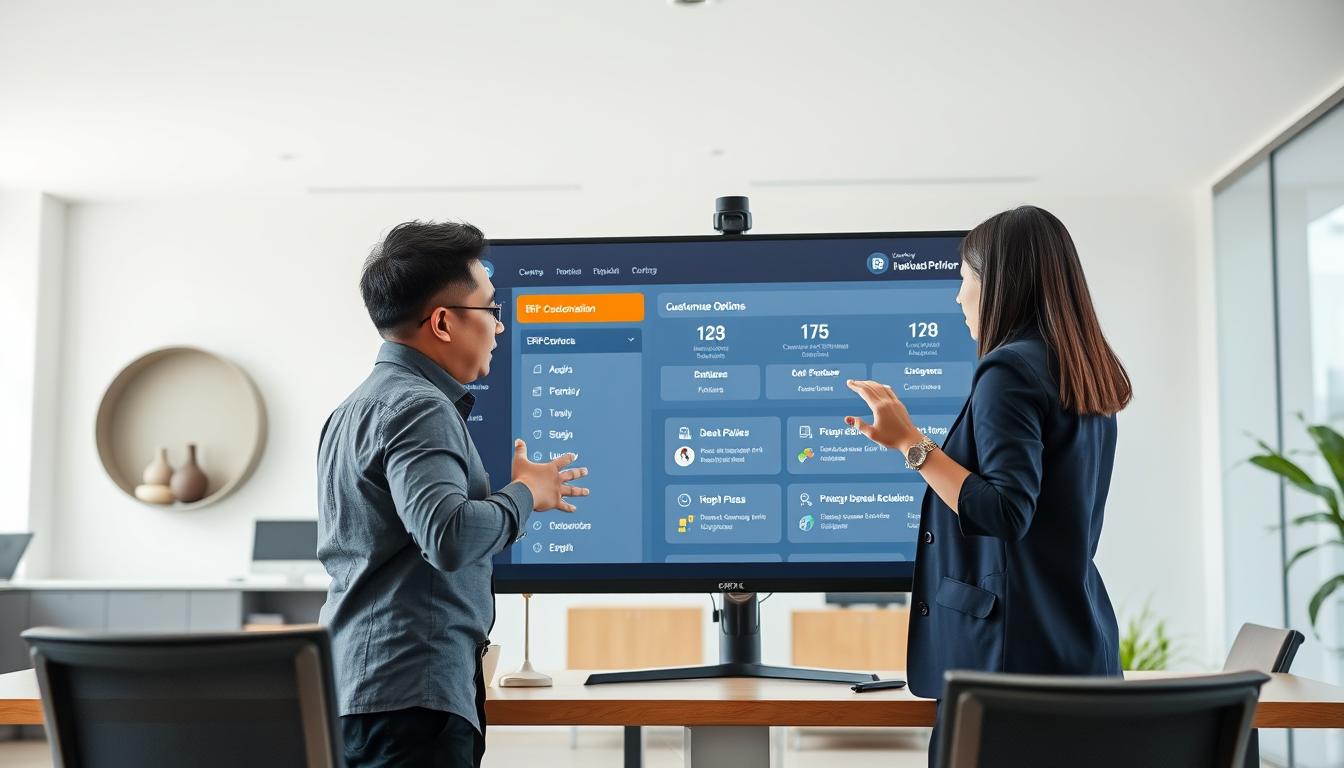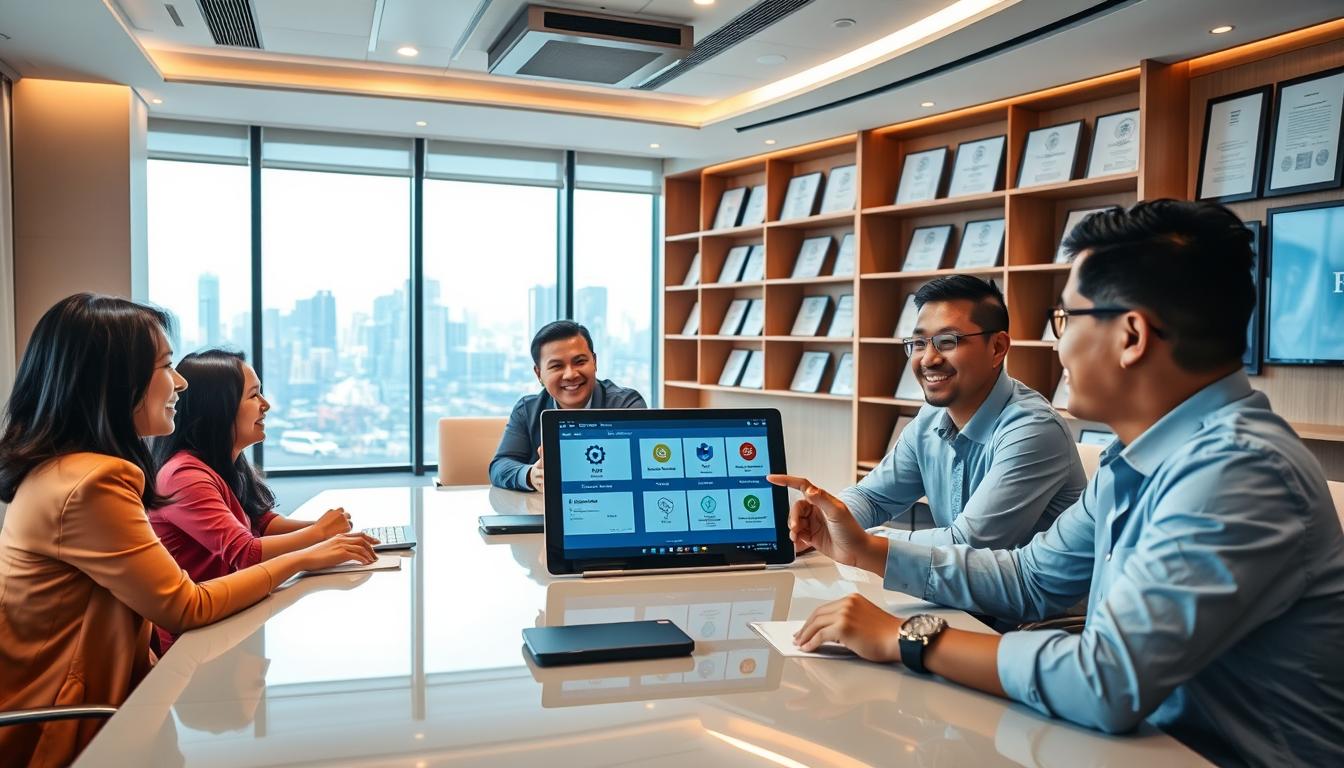Ever thought what makes successful small and medium enterprises stand out in the Philippines? Is it their new products, top-notch customer service, or their ability to manage complex operations with ERP customization? As your company grows, knowing how to use ERP systems is key. A customized ERP system can grow with your business, making operations smoother and more efficient.
In this section, we’ll look at why customizing your ERP system is important for your growing business.
Key Takeaways
- Customization is essential for adapting ERP systems to unique business processes.
- A scalable system is crucial for supporting growth and expansion.
- ERP customization can lead to improved operational performance.
- Effective customization aligns with strategic business goals.
- Small and medium enterprises can greatly benefit from tailored ERP solutions.
- Investing in ERP customization enhances productivity and efficiency.
Understanding ERP Systems and Their Importance
ERP systems are integrated software solutions that help manage different business areas. These include finance, human resources, and supply chain management. They are crucial for modern businesses, making it easier for departments to work together.
ERP systems keep all information in one place. This leads to better business efficiency and fewer mistakes. Companies using ERP often see a big boost in productivity. A survey showed a 30% increase in output for those who adopted ERP.
In the Philippines, small and medium enterprises (SMEs) are starting to see ERP’s value. Local businesses like Zalora and Puregold use ERP to manage their inventory and customer data. This has helped them perform better in the market.
| Benefits of ERP Systems | Impact on Business |
|---|---|
| Centralized Data Management | Improved decision-making |
| Increased Business Efficiency | Reduction in operational costs |
| Real-time Analytics | Enhanced responsiveness to market changes |
| Streamlined Processes | Greater focus on core business activities |
What is ERP Customization?
ERP customization means changing a standard ERP system to fit business needs. Many companies in the Philippines face unique challenges. They need solutions that work well for them. This can include small changes or big updates to how the system looks and works.
One way to customize ERP is by linking it with other software a business uses. This makes workflows smoother and boosts productivity. It lets data move easily between different systems.
Custom solutions are key for small and medium enterprises (SMEs). They help SMEs overcome specific challenges. These solutions also help them stay ahead in the market.
With the right ERP customization, a business can match its processes with industry standards. This leads to better success in operations.
Benefits of Customizing Your ERP for Business Growth
Customizing your ERP system offers many benefits for business growth. Tailored solutions help improve workflows, making internal processes more efficient. This leads to smoother operations, allowing employees to focus on strategic tasks.
A customized ERP provides personalized user interfaces that meet specific needs. This personalization boosts employee satisfaction, as users find it easier to navigate. Customized dashboards give users key insights, enhancing customer engagement through informed decisions.
Automated tasks in the system reduce errors and speed up processing. These advantages create an agile environment, crucial for staying competitive. Philippine SMEs can use these features to find growth opportunities they might miss.
Key Considerations Before Customizing Your ERP
Customizing an ERP system needs careful thought and planning. Businesses should first evaluate their unique needs. This ensures the customization meets their operational goals. Understanding current workflows is key for effective implementation.
Mapping these workflows helps make informed decisions. It shows which features are needed to boost efficiency.
Recognizing potential pitfalls is crucial. Unforeseen adjustments can lead to increased costs. Companies must prepare for implementation challenges, as long customization processes can slow down work.
Efficient user training is also vital. It helps users adapt quickly and get the most out of the new system.
Setting clear objectives is essential for any customization project. Companies in the Philippines aiming to streamline operations should have specific goals. This focused approach ensures resources are used well. For more insights on optimizing business processes, check this relevant resource.
Scalability & Upgrades: Preparing Your ERP for Future Needs
As businesses grow, they need ERP systems that can grow too. It’s key to keep operations running smoothly. By using modern tech, companies can make their ERP systems flexible for changing needs.
This flexibility is very important for small and medium enterprises (SMEs) in the Philippines. Being quick to adapt can make a big difference in success.
Leveraging Modern Technologies
Using cloud computing and mobile features helps ERP systems grow. These updates make it easier for companies to change and grow. For example, working from anywhere is now possible thanks to cloud tech.
Cloud solutions also make managing data and access easier. This makes it simpler to add new features as they come out.
Importance of Modular Design
A modular design makes ERP systems more flexible. It lets businesses add or remove parts easily without changing everything. This way, companies can pick what they need now and keep options open for later.
Choosing a modular design helps avoid being left behind by new tech. It keeps ERP systems up-to-date with changing needs and demands.
Best Practices for Effective ERP Customization
Customizing an ERP system well needs a clear plan. It’s about working with stakeholders and keeping the system up to date. By following the best practices, you can make your ERP work better and faster. Every step should include important people to make sure it fits with your company’s goals and what users need.
Engaging Stakeholders
Getting people from all levels of your company involved is key to a good ERP customization. Talking to these folks helps them accept the change and gives you real feedback. You should include:
- End-users who will use the system
- Management to share the big picture
- IT pros who handle the tech side
Having regular talks and getting feedback helps everyone work together. This way, the system really shows what your business is all about.
Regular Maintenance and Updates
Don’t forget about keeping your ERP system in top shape. Setting up a plan for updates is crucial for it to run smoothly. Regular upkeep fixes problems and keeps the system in line with your business goals. Small and medium-sized businesses (SMEs) should focus on this to get the most out of their ERP without too much downtime. Important upkeep tasks include:
- Regular system checks
- Keeping software up to date
- Teaching staff about new features
By keeping your ERP system well-maintained, your business can stay ahead of the game.
Challenges of ERP Customization
Customizing an ERP system comes with its own set of challenges. Businesses face several hurdles that can impact performance and efficiency. Tackling these issues early can help manage costs and speed up implementation.
Potential Cost Implications
The cost of customizing an ERP system can be a big concern. Companies might find themselves facing unexpected expenses. For small and medium businesses, it’s crucial to manage their budget carefully.
A smart plan can prevent overspending. Staying informed about budgeting and costs, like through tracking systems, is key to making wise financial decisions.
Longer Implementation Times
Another challenge is the time it takes to implement the system. Customizations add complexity, making it take longer. This can disrupt operations and delay benefits.
Being aware of these delays helps prepare everyone involved. Tools for project management are essential. They keep the team on track and focused on goals.
| Challenge | Description | Mitigation Strategy |
|---|---|---|
| Cost Implications | Unexpected costs can arise during the customization process, stressing budgets. | Implement a detailed budget plan with a contingency fund. |
| Implementation Times | Custom features can lengthen the time before the system is fully operational. | Use project management tools to track progress and adjust timelines. |
| System Complexity | Customized systems may become harder to maintain, complicating updates. | Engage in regular training and reassessment of system features. |
Choosing the Right ERP Vendor for Custom Solutions
Choosing the right ERP vendor is key for businesses looking to tailor their ERP solutions. When choosing an ERP vendor, look at their ability to offer customized solutions. Start by checking their experience in your industry, focusing on their success with similar businesses.
Find vendors with a strong track record in creating specific ERP solutions that match your goals. Look at their portfolio, client feedback, and case studies. A vendor with a solid history means you can trust your investment.
Support services after implementation are crucial. They help build a lasting partnership that grows with your business. Make sure the vendor promises ongoing help, training, and updates. This ensures your system stays up-to-date with your needs.
Also, choose vendors with customizable modules. This lets your ERP solutions grow and change as your business does. In today’s fast business world, being able to adapt is key.
Case Studies: Successful Customizations in Philippine SMEs
In recent years, many SMEs in the Philippines have successfully customized their ERP systems. These case studies ERP Philippines show how tailored ERP solutions boost productivity and customer satisfaction. They do this across different industries.
A local manufacturing firm is a great example. They customized their ERP to manage inventory better and streamline production. This led to more efficient operations, less delays, and fewer inventory mistakes. Thanks to this, the company grew, expanding its market reach.
Another example is a retail business that improved its e-commerce with ERP customization. They added real-time analytics and customer management tools. This move boosted their online sales and made customers happier. It showed the strength of successful ERP customization in driving SME growth.
These stories show how different SMEs in the Philippines have customized their ERP systems. They highlight the benefits of tailored ERP solutions. These benefits go beyond just making operations better. They also show a path to growth and staying competitive in a changing market.
Conclusion
ERP customization is key for modern businesses, and even more so for SMEs in the Philippines. It makes processes work together smoothly, boosts efficiency, and helps businesses grow. While it has its challenges, the benefits are worth it in the long run.
Businesses need to grow and adapt in a changing market. A flexible ERP system is essential for this. It allows businesses to adjust and expand easily. ERP customization is a must for staying ahead and being quick to change.
For SMEs, ERP customization is a key part of their growth plan. It helps them handle industry challenges and prepares them for the future. A customized ERP system is a powerful tool for success.




